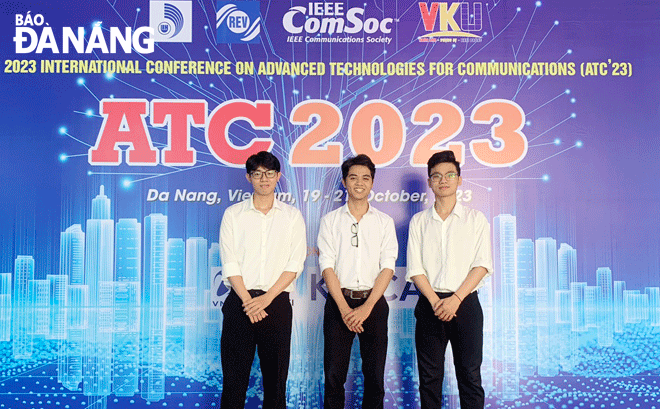Student-made scientific research put into practice
At the 2023 Da Nang Scientific Research Contest for Students recently launched by the municipal Department of Science and Technology and the Youth Union, many projects in the fields of healthcare, education and technology have been highly appreciated by experts due to their high practical applicability.
 |
| The group of students from the Viet Nam-Korea University of Information and Communication Technology has developed AI solution in early diagnosis using a comprehensive approach from clinical to paraclinical diagnosis, which won second prize in the 2023 Da Nang Scientific Research Contest for Students. Photo: CHIEN THANG |
Application of AI in medicine
The project on providing solutions to apply artificial intelligence (AI) in early diagnosis based on a comprehensive approach from clinical to paraclinical diagnosis in the medical field by a group of students from the Viet Nam-Korea University of Information and Communication Technology (VKU) is one of the topics highly appreciated by the organisers and experts for its high practical applicability.
The students have developed two models of clinical diagnostic machines based on symptoms and machines to localise abnormalities on lung X-ray films.
They have built a website that helps users interact easily and provides a number of other useful functions related to doctors’ preliminary diagnosis process such as making an online appointment with doctors, tracking medical records, and searching for the nearest hospital on AI models.
Pham Vu Thu Nguyet, leader of the team, said that with the machine learning model for automatic clinical diagnosis, the approach proposed in this study includes three separate algorithms: Naive Bayes, Decision Trees and Random Forest.
From the process of model research and building in diagnostic and paraclinical methods, a system is created by using deep learning techniques to automatically localise and classify abnormalities from chest X-ray images.
By applying Windows Presentation Foundation (WBF) techniques in the data preprocessing step to integrate resources will reduce the possibility of model confusion while avoiding deletion of useful serving data.
The students intend to develop research using an approach that combines natural language processing and time series data to analyse comprehensively information from patients’ medical record histories, thereby improving the accuracy of the model's diagnostic process, and system quality.
The group's limitation is that it cannot access accurate and timely information when medical data, especially abnormal data, is very difficult to collect. Therefore, they plan to expand the data set, and increase the diversity and quality of information and data.
To do that, the team hopes to connect with doctors or medical experts to receive product reviews. This will be a valuable basis for the team to continue developing research to best meet the needs of people in the industry. At the same time, the group hopes to receive support from hospitals to pilot and develop this model.
Life jacket applies IoT platform
A group of students from the Da Nang University of Technical Education have developed a life jacket applying IoT technology equipped with sensors and wireless network connections to monitor the location and condition of people in danger in the water.
When detecting incidents, the life jacket automatically sends rescue notifications to rescue stations and rescue workers. The application of IoT technology in this solution also helps improve data management and analysis of drowning accidents. The data can be used to analyse trends, take preventative measures, and create safety for travellers.
According to team leader Duong Bao Nguyen, the smart life jacket system applying the IoT platform has two main components: the technology life jacket and the management application software.
Through testing in different underwater environments, life jackets have proven to be reliable, versatile and effective in personal rescue and protection activities.
However, the life jacket depends on the GSM signal of the phone SIM card, so it can only be used near the location of the broadcasting station near the shore.
In the future, the team will research and develop new technologies to reduce the size of the life jacket, while improving the accuracy and reliability of sensors to make sure to get accurate data and fewer mistakes.
Reporting by CHIEN THANG - Translating by M.DUNG